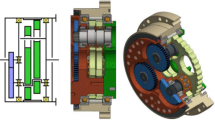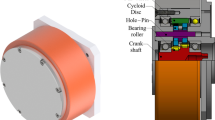Abstract
In the previous study, the authors showed the results that the cycloid gear pair with tooth number difference of two does not only increase the contact ratio and decrease the maximum shared load of the individual contact tooth pair, but also reduce the bearing loads of the cranks slightly. However, stress concentration occurs on the tip segment of cycloid teeth, if no suitable flank modification is available. The aim of the paper is to propose a new design approach for flank modification of cycloid profile to improve the contact characteristics. Besides the conventional methods for flank modification, i.e. equidistant offset and shifting offset modification, a new flank modification with multiple variables, so-called free profile modification, is proposed in the paper. Only the cycloid planetary stage with two cycloid discs are considered in the study to simplify the analysis. Two analysis approaches, tooth contact analysis and loaded tooth contact analysis, are developed for evaluation of the modified profile accordingly. A method based on the geometrical property of cycloid profile, named “tracing circle method”, is employed to determine exactly the contact points and the other kinematic characteristics of drives. The developed LTCA approach based on the influence coefficient method is used to calculate the contact stress of the modified cycloid tooth pair with considering the stiffness of supporting bearings and the influence of the eccentric error of the cycloid disc. The variation of shared load, the contact stress, the bearing load and the torque distribution are analysed in the paper to evaluate the various flank modification methods. Some useful design guidelines, summarized from the systematic analysis results, are also given in the paper.
Zusammenfassung
In der vorangegangenen Arbeit haben die Autoren gezeigt, dass das Zykloiden-Zahnradpaar mit einer Zähnezahlunterschied von zwei nicht nur der Überdeckungsgrad erhöht und die maximale verteilte Last des einzelnen Kontaktzahnpaars verringert, sondern auch die Lagerbelastung der Kurbeln ein wenig verringert. Die Spannungskonzentration tritt jedoch am Zahnkopfsegment des Zykloidenprofils, wenn keine geeignete Flankenmodifikation verfügbar ist. Das Ziel des Aufsatzes besteht darin, ein neues Konstruktionsverfahren für die Flankenmodifikation des Zykloidenprofils vorzuschlagen, um die Kontakteigenschaften zu verbessern. Neben den herkömmlichen Verfahren zur Flankenmodifikation, d. H. die Methode der Äquidistanzversetzung und der Profilverschiebung, wird in diesem Aufsatz eine neue Flankenmodifikation mit mehreren Variablen, die sogenannte freie Profilmodifikation, vorgeschlagen. Zur Vereinfachung der Analyse wird in der Studie nur die zykloide Planetenstufe mit zwei Zykloidenscheiben berücksichtigt. Zwei Analyseverfahren, die Zahneingriffsanalyse und die Lastverteilungsanalyse, werden entwickelt, um das modifizierte Profil entsprechend zu bewerten. Mit einer Methode, die auf der geometrischen Eigenschaft des Zykloidenprofils basiert und als „Methode des Tracing-Kreises“ bezeichnet wird, werden die Eingriffspunkte und die anderen kinematischen Eigenschaften von Antrieben genau bestimmt. Das entwickelte LTCA-verfachren, das auf der Einflusskoeffizientenmethode basiert, wird verwendet, um die Kontaktspannung des modifizierten Zykloiden-Zahnpaars unter Berücksichtigung der Steifigkeit von Stützlagern und des Einflusses des exzentrischen Fehlers der Zykloidenscheibe zu berechnen. Die Variation der verteilten Last, die Kontaktspannung, und die Lagerbelastung werden in der Arbeit analysiert, um die verschiedenen Flankenmodifikationsmethoden zu bewerten. Einige nützliche Konstruktionsrichtlinien, die aus den systematischen Analyseergebnissen zusammengefasst wurden, sind ebenfalls in dem Aufsatz enthalten.































Similar content being viewed by others
References
Tsai SJ, Chang LC, Huang CH (2017) Design of cycloid planetary gear drive with tooth number difference of two. Forsch Ingenieurwes 81:325–336
Transmission Machinery Co., Ltd. http://www.transcyko-transtec.com/
Chen BK, Fang TT et al (2008) Gear Geometry of cycloid drive. Sci China Ser E‑Tech Sci, pp 598–610
Hwang YW, Hsieh CF (2006) Geometry design and analysis for trochoidal-type speed reducer with conjugate envelopes. Transaction, of the CSME, pp 261–278
Hsieh CF (2015) Traditional versus improved designs for cycloidal speed reducers with a small tooth difference: the effect on dynamics. Mech Mach Theory 86:15–35
Cao DJ et al (2017) Dynamic transmission accuracy analysis of a RV reducer rigid-flexible coupled effect. ASME, DET, pp C2017–67063
Lin KS, Cang KY, Lee JJ (2018) Kinematic error analysis and tolerance allocation of cycloid gear reducers. Mech Mach Theory 124:73–91
Lin WS, Shih YP, Lee JJ (2014) Design of a two-stage cycloidal gear reducer with tooth modifications. Mech Mach Theory 17:184–197
Blanche JG (1989) D.; Yang, C. H.: “Cycloid Drives With Machining Tolerances”. J Mech Transm Autom Des No 111(3):337–344
Yang DCH, Blanche JG (1990) Design and application guidelines for cycloid drives with machining tolerances. Mech Mach Theory. https://doi.org/10.1016/0094-114X(90)90064-Q
Hidaka T, Wang HY et al (1994) No. 570. Rotational Transmission Error of K‑H-V-Planetary Gears with Cycloid Gear, 1st Report, Analytical Method of the Rotational Transmission Error. Transactions of JSME, Ser. C, vol 60, pp 645–653
Li X et al (2017) Analysis of a cycloid speed reducer considering tooth profile modification and clearance-fir output mechanism. ASME, vol 139, pp 33303–33301
Hansson H, Khoshaba S (2012) Design of a planetary-cyclo-drive speed reducer cycloid stage, geometry, element analyses. Thesis, Linnaeus Univ
Ren ZY et al (2017) Tooth modification and dynamic performance of the cycloidal drive. Mech Syst Signal Process 82:857–866
Tsai SJ, Huang CH, Yeh HY, Huang WJ (2015) Loaded tooth contact analysis of cycloid planetary gear drives, Proc. of IFToMM 14th World Congress. https://doi.org/10.6567/IFToMM.14TH.WC.OS6.014
Tsai SJ, Huang WJ, Huang CH (2015) A computerized approach for load analysis of planetary gear drives with epitrochoid-pin tooth-pairs, VDI-Berichte 2255.1:307–317
Huang CH, Tsai SJ (2017) No.6. A Study on loaded tooth contact analysis of a cycloid planetary gear reducer considering friction and bearing roller stiffness. J Adv Mech Des Syst .11, vol 11
Rogers D (2000) An introduction to NURBS. Morgan Kaufmann, San Francisco
Litvin FL (1994) Gear Geometry and Applied Theory. PTR. Prentice-Hall, Englewood Cliffs, New York, U.S.A
Wu SH, Tsai SJ (2009) Contact stress analysis of skew conical involute gear drives in approximate line contact. Mech Mach Theory 44:1658–1676
Acknowledgements
The authors would like to thank the Ministry of Science and Technology, Taiwan (MOST105-2221-E-08-042-MY3) and Transmission Machinery Co., Ltd., Taiwan for their financial support.
Author information
Authors and Affiliations
Corresponding author
Rights and permissions
About this article
Cite this article
Chang, LC., Tsai, SJ. & Huang, CH. A study on tooth profile modification of cycloid planetary gear drives with tooth number difference of two. Forsch Ingenieurwes 83, 409–424 (2019). https://doi.org/10.1007/s10010-019-00355-4
Received:
Accepted:
Published:
Issue Date:
DOI: https://doi.org/10.1007/s10010-019-00355-4




